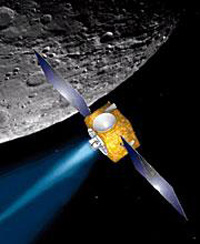European spacecraft sends back unexpectedly rich data
The SMART-1 spacecraft sent back an unexpectedly rich data haul that could shed light on the origins and the evolution of the Moon. The data was gathered during a three-year voyage which ended with a planned crash of the spacecraft on the lunar surface , European space scientists said Monday.

The mission's primary purpose was to test a new, efficient propulsion system and better spacecraft automation for future interplanetary missions. But successes in lowering the craft's orbit around the moon meant a closer and better look at surface, they said.
"It was really a great mission for the agency," mission manager Gerhard Schwehm said at a news conference at the European Space Agency's mission control center in Darmstadt, Germany. "It was a technology demonstrator that grew up and provide lots of beautiful science data."
The SMART-1 mission came to an end Sunday morning when the craft smashed into a volcanic plain called the Lake of Excellence at 7,200 kilometers per hour (4,475 miles per hour), AP reports.
During its months in lunar orbit, ground controllers managed to shrink the orbit so that the craft went around every five or six hours instead of every 14 hours. That multiplied the amount of data from its X-ray and infrared spectrometers scanning the surface below.
The X-ray scanner - miniaturized to about the size of a toaster - continued working until two seconds before the impact, said the scientist in charge of the device, Manuel Grande of the University of Wales.
The scanner is the first to be able to detect calcium from orbit - a major advance because it meant the device could measure and map all the main elements that make up the moon: aluminum, magnesium, silicon, calcium and iron.
"What was particularly pleasing was the calcium signal," Grande said "This is the first time we've been able to take an inventory of all the rock-forming elements of the moon."
U.S. astronauts explored parts of the moon's surface during the Apollo missions, but SMART-1 was able to scan the entire surface. It flew over the Apollo landing sites so scientists could use the astronauts' findings from three decades ago to verify that the information from SMART-1's instruments was indeed accurate.
Researchers will process the raw data over the next year, and the expanded understanding of the moon's composition, it is hoped, will help test the theory that the moon resulted from a collision between the earth and another astronomical body. The data will also underpin studies of how the moon's surface evolved, for instance which features came from volcanic activity and which from impacts.
The X-ray device is slated to fly on India's Chandrayaan-1 lunar orbiter in 2007-2008, during a period when higher X-ray emissions from the sun should mean even better data, he said. "We think it's going to do great lunar science."
SMART-1 was launched Sept. 27, 2003 from the European launch facility Kourou, French Guiana. Once in Earth orbit, it used a small ion engine - emitting a stream of electrically charged particles instead of burning rocket fuel - to raise its orbit over 14 months until the moon's gravity grabbed it.
The engine, which saves weight on fuel so spacecraft can carry more instruments, will power the Bepi-Colombo mission to Mercury expected for 2013.
Subscribe to Pravda.Ru Telegram channel, Facebook, RSS!


